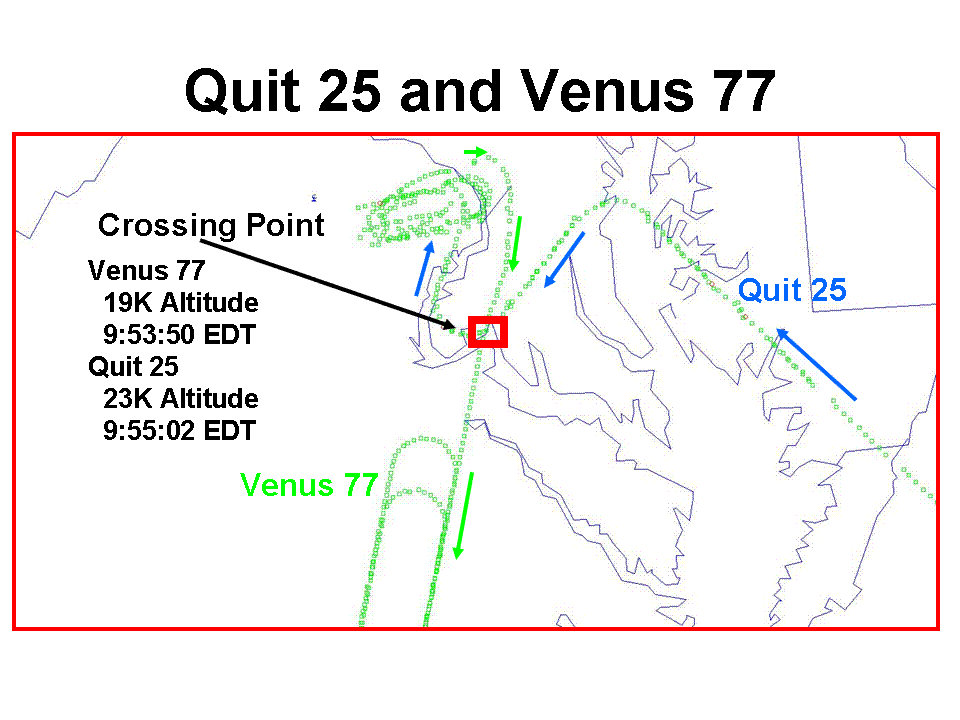Background
I have been in an extended email discussion with Paul Schreyer concerning the Langley Scramble. My position was established in the “gang aft agley” paper (and Addendum) several years ago. Succinctly, the Langley scramble was a serious of understandable, logical individual events that did not cohere in the aggregate.
Schreyer’s position is based on a false flag theory which let to his “anomalies” paper published elsewhere on the web. To try and help Schreyer clarify his understanding I came up with a different perspective, one I shared with him.
A Different Perspective
Schreyer believes that the scramble order, itself, was changed. That is not accurate, it remained the baseline for the scramble as it developed. Langley Tower could not translate the scramble order to a flight plan that they were confident the air traffic control system would accept without trial and error. Therefore, they used a proven flight plan, one of long standing, zero nine zero for 60 (090 for 60) nautical miles.
Comparing a scramble order to a flight plan is problematic. It is an apples and oranges comparision; two distinct and separate processes. A scramble order is simply a device to get the air defense fighters into the air so that weapons controllers can then tell them what to do. The flight plan is the air traffic control means of getting the fighters safely into the national airspace system. It requires a direction and a distance. The scramble order issued did not included a distance. However, Langley Tower air traffic controllers were confident using a standard flight plan, knowing from experience that weapons controllers would take over. Except they didn’t, and therein lie the details.
What happened
The procedures in place, to include 090 for 60 (a flight plan) were cold war era practices that survived into the anti-drug era. Northeast Air Defense Sector (NEADS) weapons controller radios could not reach the Langley fighters at low altitude once airborne, but that didn’t matter because the flight plan 090 for 60 delivered the fighters to military airspace controlled by Navy air traffic controllers at a facility known as Giant Killer. Those controllers were responsible for air traffic control in off shore training areas.
Giant Killer could then act as a relay to NEADS, just as they did on 9/11. It was Norfolk TRACON/Tower’s intermediate responsibility to take control of the fighters once in the national air space system and then hand them off to Giant Killer prior to entry into the training area, as they did on 9/11, unless the lead pilot requested otherwise.
On 9/11 the flight lead, Quit 25, did not tell Norfolk to send him North to get back on the scramble azimuth. In the heat of battle, in the chaos of the morning, he elected to continue east and was handed off to Giant Killer. Giant Killer was in contact with NEADS and did turn the fighters at NEADS request, direct Baltimore. Nothing was known about AA 77 and the threat it posed. The perceived threat was AA 11 bearing down on the nation’s capital from the North.
There is no fault that accrues to Langley, the tower controllers did their job and, in their words, would do the same thing again if they had it to do over. I did mark NEADS down in a report card issued on 9/11/11 for not knowing how scrambles actually proceeded at Langley, by the way.
Why it happened
Here, we turn to chaos theory for an understanding. The Langley scramble, writ large and in detail, is an excellent example of sensitive dependence on initial conditions. Those initial conditions include a cold war era structure and policy; an emphasis on counter drug operations; and a requirement to identify all planes entering the Air Defense Identification Zone (ADIZ). NEADS (and NORAD) was, as General McKinley testifed to the Commission in May, 2003, “focused outward.”
Scramble missions had to do with either drug runners (counterdrug operations), special cold war-related tracks (Aeroflot, China Air, Cubana), or DVFR (Defense visual flight rules) flights–fish spotters, cable checkers, doctors and dentists, “Moms and Pops,” who filed to exit the ADIZ (Air Defense Identification Zone) and then forgot to turn their transponders back on when re-entering the ADIZ. The standard flight plan at Langley Tower was a proven method of getting the fighters to altitude, over water, and headed East to prosecute any of those missions.
NEADS controllers on 9/11 did not understand the standard techniques in place at Langley. As the NEADS tapes reveal, the weapons controller technician did “not know why” the fighters were headed toward an off shore training area.
For perspective, interested readers should review my series of Vigilant Guardian articles covering the period Sep 3-11, 2001. (scroll down to third article in the category) The “Moms and Pops” reference comes from my interviews of nearly two dozen Southeast Air Defense Sector (SEADS) Mission Crew Commanders during my work on the Brothers To The Rescue project while at the Department of Defense, Office of the Inspector General.
Who participated
Altogether, eight individuals, who I will identify by position, caused the Langley scramble to happen as it did, up to the point that NEADS realized the flight had gone astray. All eight—four at NEADS, two at Langley Tower, one at Norfolk TRACON/Tower, and the lead pilot—were duly diligent and did their jobs as best they could given the information available to them. None were negligent and there was no outside voice, no unseen false flag opportunist that intervened. Their combined story is complete, coherent, and logical, understanding that NEADS did not appreciate the impact of what were standard operating procedures at Langley.
At NEADS, the weapons controller and weapons controller technician were responsible for the metrics that produced the scramble order, azimuth 010, flight level 290. The flight level was based on the last known altitude for AA 11. The senior director approved the order (with the knowledge of the Mission Crew Commander and the NEADS Commander) and it was broadcast by the senior director technician.
The broadcast was heard by Langley command post, Langley tower, the fighter detachment, Giant Killer, and Norfolk Tower/TRACON. At Langley Tower, the duty air traffic controller and his supervisor entered the flight plan, 090 for 60, into the national airspace system. Control, “radar contact,” was passed to Norfolk Tower while the fighters were taking off.
The Norfolk Tower controller knew by SOP that the fighters were to proceed on runway heading (runway 8, 80 degrees) to an altitude of 4000 feet before turning. At that point he asked the flight lead which way he wanted to go.
Quit 25, the flight lead concluded that the flight plan was later information than the scramble order and turned slightly right to a heading of 090 and continued. When I played the controller conversation back to him after our interview he said he did not recall that and that it “was an opportunity missed.”
Perspective
The Langley scramble is not nearly as askew as the graphic picture portrays. The fighters were airborne at 9:30 EDT and were not going to turn for at least two minutes. Had they turned as soon as possible, the turn would have occurred over the Delmarva Peninsula and the remaining flight time to the nation’s capital was on the order of 10-12 minutes, too late to be in position for AA 77 but well in time to guard against the approach of UA 93.
Altogether, including the false turn south on approach to Washington, DC, the Quit flight lost on the order of 15 minutes. The combat air patrol to protect the National Command Authority began at 10:00 EDT, twenty-two minutes after AA 77 slammed into the Pentagon at 9:38 EDT.
In a perfect world it is conceivable that the Langley fighters would have reached the nation’s capital concurrent with the arrival of AA 77, but with no authority to do anything, as General Larry Arnold testified to the Commission. The national level was just getting organized. When the Pentagon was hit the National Military Command Center had just convened an Air Threat Conference; FAA had not yet joined. At the White House, the Richard Clarke-chaired secure video teleconference convened at 9:40 EDT when FAA Administrator Jane Garvey joined the conference.

